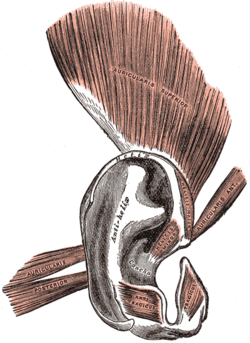| Posterior auricular muscle | |
|---|---|
 The muscles of the auricula The muscles of the auricula | |
 Auricula in context. Auricula in context. | |
| Details | |
| Origin | Mastoid process of temporal bone |
| Insertion | Posterior part of auricle of outer ear |
| Artery | Posterior auricular artery |
| Vein | Posterior auricular vein |
| Nerve | Posterior auricular nerve of facial nerve (VII) |
| Actions | Pulls ear backward |
| Identifiers | |
| Latin | musculus auricularis posterior |
| TA98 | A04.1.03.022 |
| TA2 | 2091 |
| FMA | 46857 |
| Anatomical terms of muscle[edit on Wikidata] | |
The posterior auricular muscle is a muscle behind the auricle of the outer ear. It arises from the mastoid part of the temporal bone, and inserts into the lower part of the cranial surface of the auricle of the outer ear. It draws the auricle backwards, usually a very slight effect.
Structure
The posterior auricular muscle is found behind the auricle of the outer ear. It consists of two or three fleshy fasciculi. These arise from the mastoid part of the temporal bone by short aponeurotic fibers. They insert into the lower part of the cranial surface of the auricle of the outer ear.
The posterior auricular muscle is supplied by branches of the posterior auricular artery, which continues deep to the muscle. It is drained by the posterior auricular vein that accompanies the artery.
Nerve supply
The posterior auricular muscle is supplied by the posterior auricular nerve, a branch of the facial nerve (VII).
Function
The posterior auricular nerve draws the auricle of the outer ear backwards. This effect is usually very slight, although some people can wiggle their ears due to a more significant muscle movement.
Postauricular reflex
The postauricular reflex is a vestigial myogenic muscle response in humans that acts to pull the ear upward and backward. Research suggests neural circuits for auricle orienting have survived in a vestigial state for over 25 million years. It is often assumed the reflex is a vestigial Preyer reflex (also known as the pinna reflex).
A study on auriculomotor activity found that in the presence of sudden, surprising sounds, the muscles around the ear closest to the direction of the sound would respond by moving involuntarily, causing the pinna to be pulled backwards and flatten.
Clinical significance
If the posterior auricular muscle inserts into an unusual part of the auricle of the outer ear, this can cause protruding ears. In one study, the muscle was found to be absent in 5% of people.
See also
References
 This article incorporates text in the public domain from page 1035 of the 20th edition of Gray's Anatomy (1918)
This article incorporates text in the public domain from page 1035 of the 20th edition of Gray's Anatomy (1918)
- ^ Yotsuyanagi, Takatoshi; Yamauchi, Makoto; Yamashita, Ken; Sugai, Asuka; Gonda, Ayako; Kitada, Ayaka; Saito, Tamotsu; Urushidate, Satoshi (July 2015). "Abnormality of Auricular Muscles in Congenital Auricular Deformities". Plastic and Reconstructive Surgery. 136 (1): 78e – 88e. doi:10.1097/PRS.0000000000001383. ISSN 0032-1052. PMID 26111335. S2CID 23651843.
- ^ Niamtu, Joseph (2018). "8 - Cosmetic Otoplasty and Related Ear Surgery". Cosmetic Facial Surgery (2nd ed.). Edinburgh: Elsevier. pp. 473–532. doi:10.1016/B978-0-323-39393-5.00008-X. ISBN 978-0-323-39402-4. OCLC 976037123.
- Barral, Jean-Pierre; Croibier, Alain (2009). "25 - Ear". Manual Therapy for the Cranial Nerves. Edinburgh: Churchill Livingstone / Elsevier. pp. 227–238. doi:10.1016/B978-0-7020-3100-7.50028-8. ISBN 978-0-7020-3736-8. OCLC 460904284.
- Benning, Stephen D. (2018-04-05). "The Postauricular Reflex as a Measure of Attention and Positive Emotion". Oxford Handbooks Online. doi:10.1093/oxfordhb/9780199935291.013.74. ISBN 978-0-19-993529-1.
- Benning, Stephen D. (2011-03-01). "Postauricular and superior auricular reflex modulation during emotional pictures and sounds". Psychophysiology. 48 (3): 410–414. doi:10.1111/j.1469-8986.2010.01071.x. ISSN 1469-8986. PMC 2962877. PMID 20636290.
- Hackley, Steven A. (2015-10-01). "Evidence for a vestigial pinna-orienting system in humans". Psychophysiology. 52 (10): 1263–1270. doi:10.1111/psyp.12501. ISSN 1469-8986. PMID 26211937.
- "ZFIN Behavior Ontology: pinna reflex". zfin.org. Retrieved 2020-01-05.
- Strauss, Daniel J; Corona-Strauss, Farah I; Schroeer, Andreas; Flotho, Philipp; Hannemann, Ronny; Hackley, Steven A (2020-07-03). "Vestigial auriculomotor activity indicates the direction of auditory attention in humans". eLife. 9: e54536. doi:10.7554/eLife.54536. ISSN 2050-084X. PMC 7334025. PMID 32618268.
- Benning, Stephen D. (2018-04-05). "The Postauricular Reflex as a Measure of Attention and Positive Emotion". Oxford Handbook Topics in Psychology. Vol. 1. Oxford University Press. doi:10.1093/oxfordhb/9780199935291.013.74. ISBN 978-0-19-993529-1.
| Muscles of the head | |||||||||||||||||
|---|---|---|---|---|---|---|---|---|---|---|---|---|---|---|---|---|---|
| Extraocular |
| ||||||||||||||||
| Masticatory |
| ||||||||||||||||
| Facial |
| ||||||||||||||||
| Soft palate |
| ||||||||||||||||
| Tongue |
| ||||||||||||||||